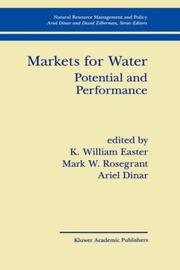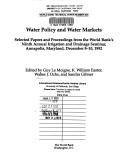| Listing 1 - 10 of 12 | << page >> |
Sort by
|
Book
ISBN: 0813371775 Year: 1986 Publisher: Boulder Westview
Abstract | Keywords | Export | Availability | Bookmark
 Loading...
Loading...Choose an application
- Reference Manager
- EndNote
- RefWorks (Direct export to RefWorks)
Irrigation --- Government policy --- Finance --- Management
Book
ISBN: 9401790817 9401790809 1322175438 Year: 2014 Publisher: Dordrecht : Springer Netherlands : Imprint: Springer,
Abstract | Keywords | Export | Availability | Bookmark
 Loading...
Loading...Choose an application
- Reference Manager
- EndNote
- RefWorks (Direct export to RefWorks)
This book evaluates the history, the present and the future of water markets on 5 continents, beginning with the institutional underpinnings of water markets and factors influencing transaction costs. The book examines markets in seven countries and three different U.S. states, ranging from village-level water markets in Oman to basin wide formal water markets in Australia's Murray-Darling River basin. Introductory chapters on the background of water markets and on transaction costs and policy design are followed by chapter length discussion of water markets as an adaptive response to climate change and of supply reliability in a changing climate. Case studies describe a variety of facets of the design and function of markets around the world: California, Chile, Spain, Oman, Australia, Canada, India and China. In analyzing these real-world examples of markets, the contributors explore water rights, and trading of rights between agricultural and urban sectors, and the principles and function of option markets. They discuss different sized approaches, from large scale, ministry-level administration of markets to informal arrangements among farmers in the same village, or groups of villages which allocate water without large investment in management and infrastructure. Discussion includes questions of why water market practices have not expanded more rapidly in arid places. The book discusses mechanisms for resolving conflicts between water rights holders as well as between water right holders and third parties impacted by water trades, and whether or not public ownership of water rights or use rights should trump private ownership and under what condition. Also covered are new and expanding categories of water use, beyond human consumption, agriculture and industry to new technologies ranging from extracting natural gas from shale to producing biofuels. The book concludes with suggestions for future water markets and offers a realistic picture of how they might change water use and distribution practices going forward.
Water-supply --- Economic aspects. --- Availability, Water --- Water availability --- Water resources --- Natural resources --- Public utilities --- Water resources development --- Water utilities --- Environmental pollution. --- Environmental law. --- Agricultural economics. --- Marketing. --- Agriculture. --- Waste Water Technology / Water Pollution Control / Water Management / Aquatic Pollution. --- Environmental Law/Policy/Ecojustice. --- Agricultural Economics. --- Farming --- Husbandry --- Industrial arts --- Life sciences --- Food supply --- Land use, Rural --- Consumer goods --- Domestic marketing --- Retail marketing --- Retail trade --- Industrial management --- Aftermarkets --- Selling --- Agrarian question --- Agribusiness --- Agricultural economics --- Agricultural production economics --- Agriculture --- Production economics, Agricultural --- Environment law --- Environmental control --- Environmental protection --- Environmental quality --- Environmental policy --- Law --- Sustainable development --- Chemical pollution --- Chemicals --- Contamination of environment --- Environmental pollution --- Pollution --- Contamination (Technology) --- Asbestos abatement --- Bioremediation --- Environmental engineering --- Factory and trade waste --- Hazardous waste site remediation --- Hazardous wastes --- In situ remediation --- Lead abatement --- Pollutants --- Refuse and refuse disposal --- Marketing --- Economic aspects --- Law and legislation --- Environmental aspects --- Water pollution. --- Environmental policy. --- Environment and state --- Environmental management --- State and environment --- Environmental auditing --- Aquatic pollution --- Fresh water --- Fresh water pollution --- Freshwater pollution --- Inland water pollution --- Lake pollution --- Lakes --- Reservoirs --- River pollution --- Rivers --- Stream pollution --- Water contamination --- Water pollutants --- Water pollution --- Waste disposal in rivers, lakes, etc. --- Government policy
Digital
ISBN: 9789401790819 Year: 2014 Publisher: Dordrecht Springer Netherlands
Abstract | Keywords | Export | Availability | Bookmark
 Loading...
Loading...Choose an application
- Reference Manager
- EndNote
- RefWorks (Direct export to RefWorks)
This book evaluates the history, the present and the future of water markets on 5 continents, beginning with the institutional underpinnings of water markets and factors influencing transaction costs. The book examines markets in seven countries and three different U.S. states, ranging from village-level water markets in Oman to basin wide formal water markets in Australia's Murray-Darling River basin. Introductory chapters on the background of water markets and on transaction costs and policy design are followed by chapter length discussion of water markets as an adaptive response to climate change and of supply reliability in a changing climate. Case studies describe a variety of facets of the design and function of markets around the world: California, Chile, Spain, Oman, Australia, Canada, India and China. In analyzing these real-world examples of markets, the contributors explore water rights, and trading of rights between agricultural and urban sectors, and the principles and function of option markets. They discuss different sized approaches, from large scale, ministry-level administration of markets to informal arrangements among farmers in the same village, or groups of villages which allocate water without large investment in management and infrastructure. Discussion includes questions of why water market practices have not expanded more rapidly in arid places. The book discusses mechanisms for resolving conflicts between water rights holders as well as between water right holders and third parties impacted by water trades, and whether or not public ownership of water rights or use rights should trump private ownership and under what condition. Also covered are new and expanding categories of water use, beyond human consumption, agriculture and industry to new technologies ranging from extracting natural gas from shale to producing biofuels. The book concludes with suggestions for future water markets and offers a realistic picture of how they might change water use and distribution practices going forward.
Environmental law --- Water supply. Water treatment. Water pollution --- Environmental protection. Environmental technology --- Agronomy --- Agriculture. Animal husbandry. Hunting. Fishery --- Marketing --- biobrandstoffen --- milieukunde --- landbouw --- landbouwbeleid --- marketing --- milieu --- waterverontreiniging --- milieurecht --- milieuverontreiniging --- milieupolitiek --- klimaatverandering --- anno 2000-2099
Book
Abstract | Keywords | Export | Availability | Bookmark
 Loading...
Loading...Choose an application
- Reference Manager
- EndNote
- RefWorks (Direct export to RefWorks)
The objective of this paper is to develop guidelines for improving cost recovery and reducing water use per unit of output. The guidelines were developed from a review of studies of irrigation reforms and interviews of 20 World Bank staff members with responsibility for irrigation sector reforms in countries from Asia to Latin America (names listed in Appendix 1). From these studies and interviews, we distilled specific reforms that are important in improving cost recovery or reducing water use, or both. Reforms needed by individual countries or projects will depend on their institutional arrangements as well as the type of irrigation and its physical condition. The second section of the paper begins by listing some reasons for low collections and provides an overview of some of the reforms that have raised collection rates. In the next section, the authors review cost-recovery principles and provide some examples of what different countries have done to recover project costs and collect water charges from users. The focus in the fourth section is on designing water charges or water markets that will give farmers an incentive to make better use of their water by reducing the amount of water used per unit of output. In the fifth section, case studies are used to determine what reforms can help improve cost recovery and increase collection rates. In addition, water pricing reforms are identified that will encourage farmers to reduce their water use per unit of output. The final section provides a summary of the reforms that are important for increasing cost recovery and encouraging farmers to improve their use of water.

ISBN: 0306472422 Year: 2002 Publisher: New York, N.Y. : Kluwer Academic/Plenum,
Abstract | Keywords | Export | Availability | Bookmark
 Loading...
Loading...Choose an application
- Reference Manager
- EndNote
- RefWorks (Direct export to RefWorks)
Book
Abstract | Keywords | Export | Availability | Bookmark
 Loading...
Loading...Choose an application
- Reference Manager
- EndNote
- RefWorks (Direct export to RefWorks)
National wealth --- Public economics --- Water supply. Water treatment. Water pollution --- Chile
Book
Year: 1987 Publisher: Saint-Paul University of Minnesota. Agricultural experiment station
Abstract | Keywords | Export | Availability | Bookmark
 Loading...
Loading...Choose an application
- Reference Manager
- EndNote
- RefWorks (Direct export to RefWorks)

ISBN: 0585320888 0792382560 Year: 1998 Publisher: Boston, Massachusetts : Kluwer Academic Publishers,
Abstract | Keywords | Export | Availability | Bookmark
 Loading...
Loading...Choose an application
- Reference Manager
- EndNote
- RefWorks (Direct export to RefWorks)
Markets for Water: Potential and Performance dispels many of the myths surrounding water markets and gives readers a comprehensive picture of the way that markets have developed in different parts of the world. It is possible, for example, for a water market to fail, and for the transaction costs in water markets to be excessive. Too often water trading is banned because the water resources have been developed with public funds and the water agencies do not want to lose control over water. There is also a concern that poor farmers or households will be disadvantaged by water trading. These concerns about public resources and the poor are not very different from those that have been voiced in the past about land sales. The problem is that in many cases the poor already have limited access to resources, but this limit is not due to water trading. In fact, water trading is likely to expand the access to water for many small-scale farmers. Markets for Water: Potential and Performance provides an analytical framework for water market establishment. It develops the necessary conditions for water markets and illustrates how they can improve both water management and economic efficiency. Finally, the book gives readers an up-to-date picture of what we have learned about water markets in a wide range of countries, from the US to Chile and India.
Water banking --- Water rights --- Water transfer --- Water-supply --- Economic aspects --- Economics. --- Environmental management. --- Environmental economics. --- Economics, general. --- Environmental Management. --- Environmental Economics. --- Management science. --- Economics --- Environmental quality --- Environmental stewardship --- Stewardship, Environmental --- Environmental sciences --- Management --- Quantitative business analysis --- Problem solving --- Operations research --- Statistical decision --- Economic theory --- Political economy --- Social sciences --- Economic man --- Environmental aspects --- Transfer of water --- Water export --- Water transportation --- Rights, Water --- Water --- Riparian rights --- Water trusts --- Availability, Water --- Water availability --- Water resources --- Natural resources --- Public utilities --- Water resources development --- Water utilities --- Law and legislation
Book
ISBN: 0935734104 Year: 1983 Publisher: Ankeny Soil Conservation Society of America
Abstract | Keywords | Export | Availability | Bookmark
 Loading...
Loading...Choose an application
- Reference Manager
- EndNote
- RefWorks (Direct export to RefWorks)
Water-supply, Agricultural --- Water-supply, Rural --- Research

ISBN: 0821328611 Year: 1994 Publisher: Washington, D.C. The World Bank
Abstract | Keywords | Export | Availability | Bookmark
 Loading...
Loading...Choose an application
- Reference Manager
- EndNote
- RefWorks (Direct export to RefWorks)
| Listing 1 - 10 of 12 | << page >> |
Sort by
|

 Search
Search Feedback
Feedback About UniCat
About UniCat  Help
Help News
News